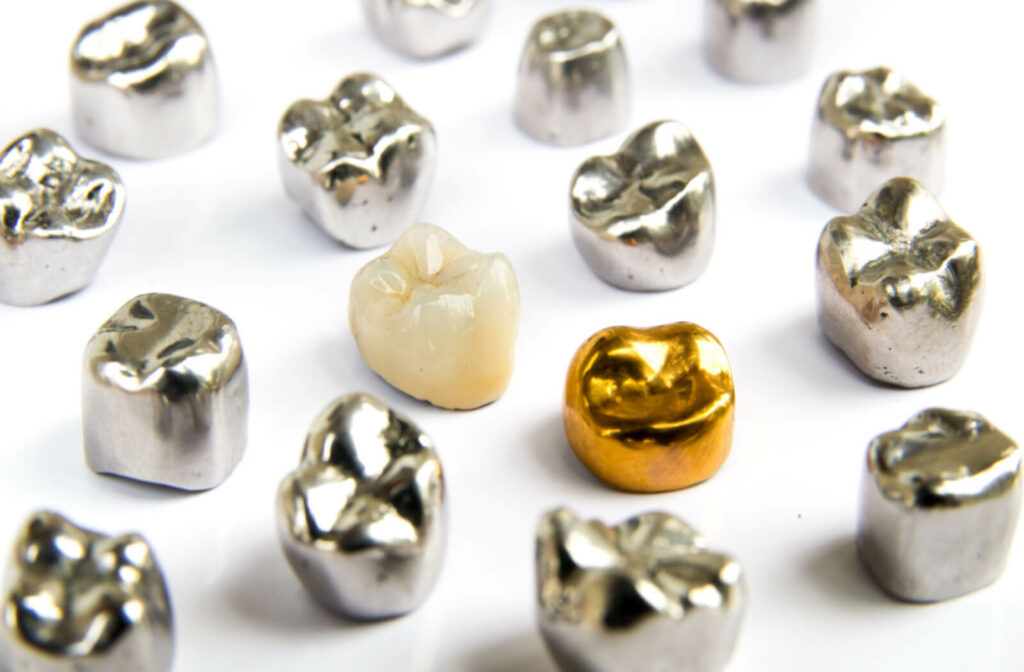Restoring a Tooth After a Root Canal
Root canal therapy and dental crowns tend to go hand-in-hand, but how do you know if you need a crown? After endodontic treatment, are there more benefits to receiving a crown or leaving your natural tooth exposed?
What Is Root Canal Treatment?
Teeth have layers. The visible tooth or crown is the top part of the tooth. It’s made of enamel, the toughest tissue in the human body, harder than steel. Enamel crushes food and protects the sensitive inner layers from bacteria or injury. Although enamel is tough, it can wear thin due to bacteria buildup in dental plaque and tartar.
The bacteria produce acids that erode enamel and lead to cavities and tooth decay. Over time, the bacteria can reach the inner tooth layers, dentin (dense tissue below the enamel) and pulp (jelly-like centre containing nerves and blood vessels).
The dental roots in the pulp cavity support the tooth by providing nutrients, securely holding the tooth in place, and controlling pressure when chewing. When the pulp or roots are exposed, infected, or damaged, it can cause:
- Gums swelling
- Tooth discolouration
- Tooth abscess
- Tooth sensitivity or pain
- Tooth loss or bone loss
Removing the infected or injured pulp is necessary to prevent worsening symptoms. In some cases, severe damage may require a tooth extraction—where the entire tooth is removed. After an extraction, a dental implant is placed into the empty socket. The artificial root acts as an anchor for a replacement tooth.
With root canal treatment, only the inner layers are removed. Next, the pulp cavity and root canal are cleaned, filled with an artificial pulp, and sealed. The procedure restores the natural tooth so it can feel and function normally. Sealing the tooth also prevents new infections.
Although a root canal treatment can save a tooth, it cannot undo damage to the tooth’s appearance or external structure. After removing the inner tissue, the tooth sometimes needs reinforcement with a dental crown.
What Is a Dental Crown?
A dental crown or cap is placed over the top of a tooth to restore shape and support function. Crowns are usually recommended after a root canal, to repair a broken tooth, or in place of a large filling. Additionally, a crown helps cover cosmetic imperfections, such as discolouration or a misshapen tooth. A crown can also protect the structure of the jaw and face.
Crowns are available in various materials, including acrylic, metal, porcelain, and bonded to metal. All-porcelain crowns are the most natural-looking, while metal is the strongest.
A dentist creates a customized crown after taking an impression of the intended tooth. Then, patients are fitted with a temporary cap until the permanent, custom crown is ready. Generally, crowns last 10 years or more.
However, a crown may not be a practical option when tooth integrity is compromised by severe tooth decay or gum disease. Therefore, before recommending a crown, or any cosmetic dentistry, the dentist first assesses tooth and gum health. In some cases, resolving dental health conditions, such as periodontal disease, may be necessary before fitting a crown.

Is a Crown Always Needed?
There are many benefits to receiving a crown. One study published in the Journal of Endodontics found placing a crown after a root canal procedure resulted in a 90% tooth survival rate. However, there are some cases where patients may not need a crown.
The remaining tooth may be healthy enough without a crown when detected and treated early. A filling may be adequate to seal any cavities or cover imperfections.
Typical reasons your dentist may recommend a crown after a root canal treatment include:
- Adding a layer to protect from tooth sensitivity (cold, hot, etc.)
- Improving appearance (removing the pulp can affect the natural tooth colour)
- Preventing new infection (previously infected or injured teeth are at higher risk)
- Strengthening a tooth weakened by injury or the trauma of removing tissue
Your dentist will recommend a crown based on their dental health integrity assessment. Still, knowing more about why the decision is made can help patients understand why they might need a crown.
Some key questions to determining the need for a crown are:
- Do you grind your teeth? Bruxism (teeth grinding) can damage the teeth or jaw. A crown can prove a layer of protection.
- What is the tooth’s condition? After a root canal treatment, parts of the tooth have been removed. A crown can help protect the weakened tooth.
- Where is the tooth located? Back teeth (molars and premolars) sustain more pressure and emit more force when chewing. Front teeth (incisors and canines) receive less strain throughout the day.
- Has the tooth been treated before? When a tooth has received previous restoration procedures, such as fillings, a crown can improve the tooth’s integrity.
Putting Your Dental Health First
You use your teeth every day for chewing, talking, and much more. When your dental health is at risk receiving appropriate treatment as soon as possible is crucial. Root canal treatment can save a tooth, and a crown can restore the function or appearance. But there are benefits to other restorative or cosmetic treatments.
When you need professional advice or skilled dental care, contact us. Arch Dental Centres conveniently provide patients with a range of services, from routine to specialist care. We strive to put your needs and dental health first. Request an appointment today!


